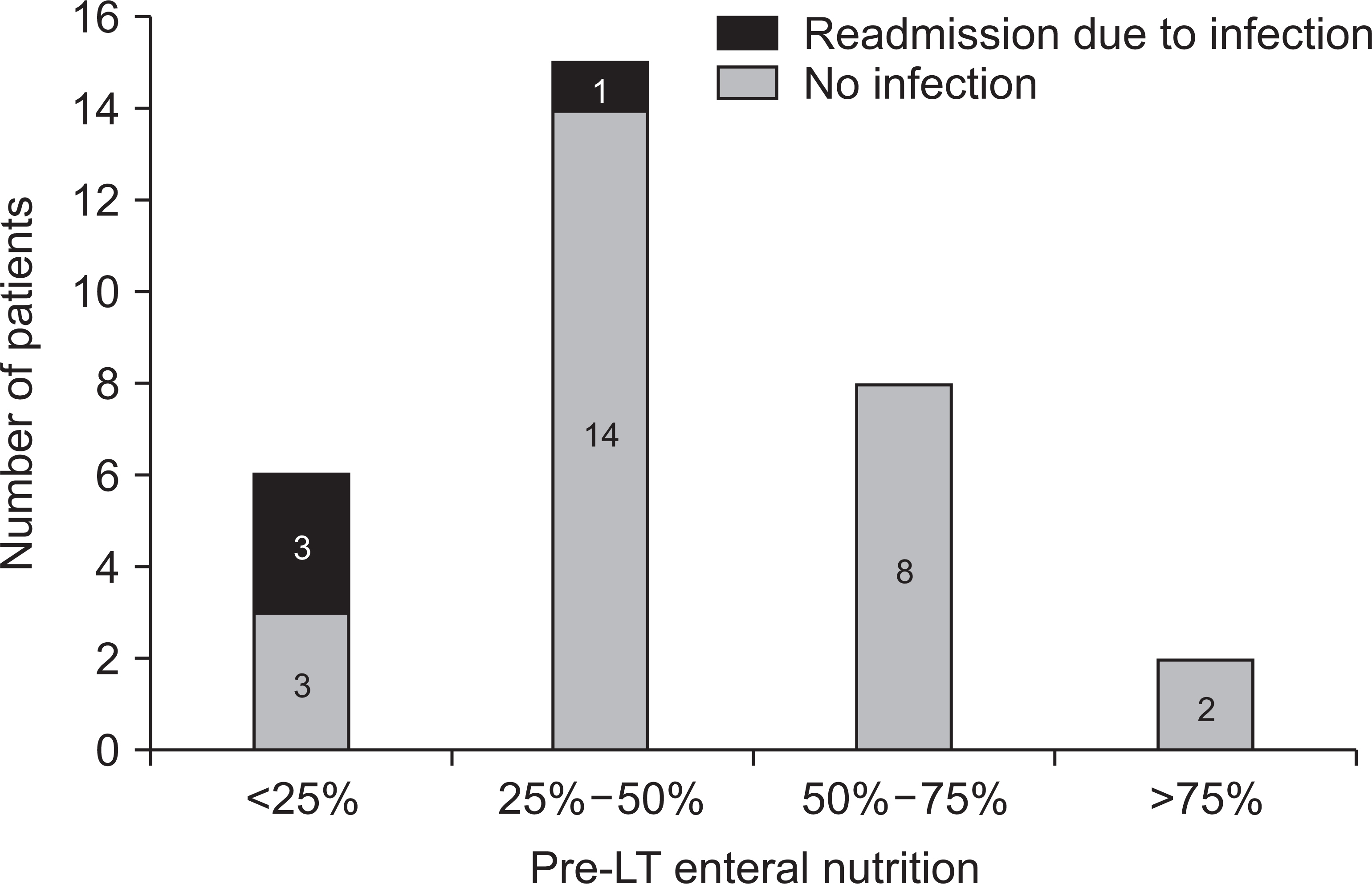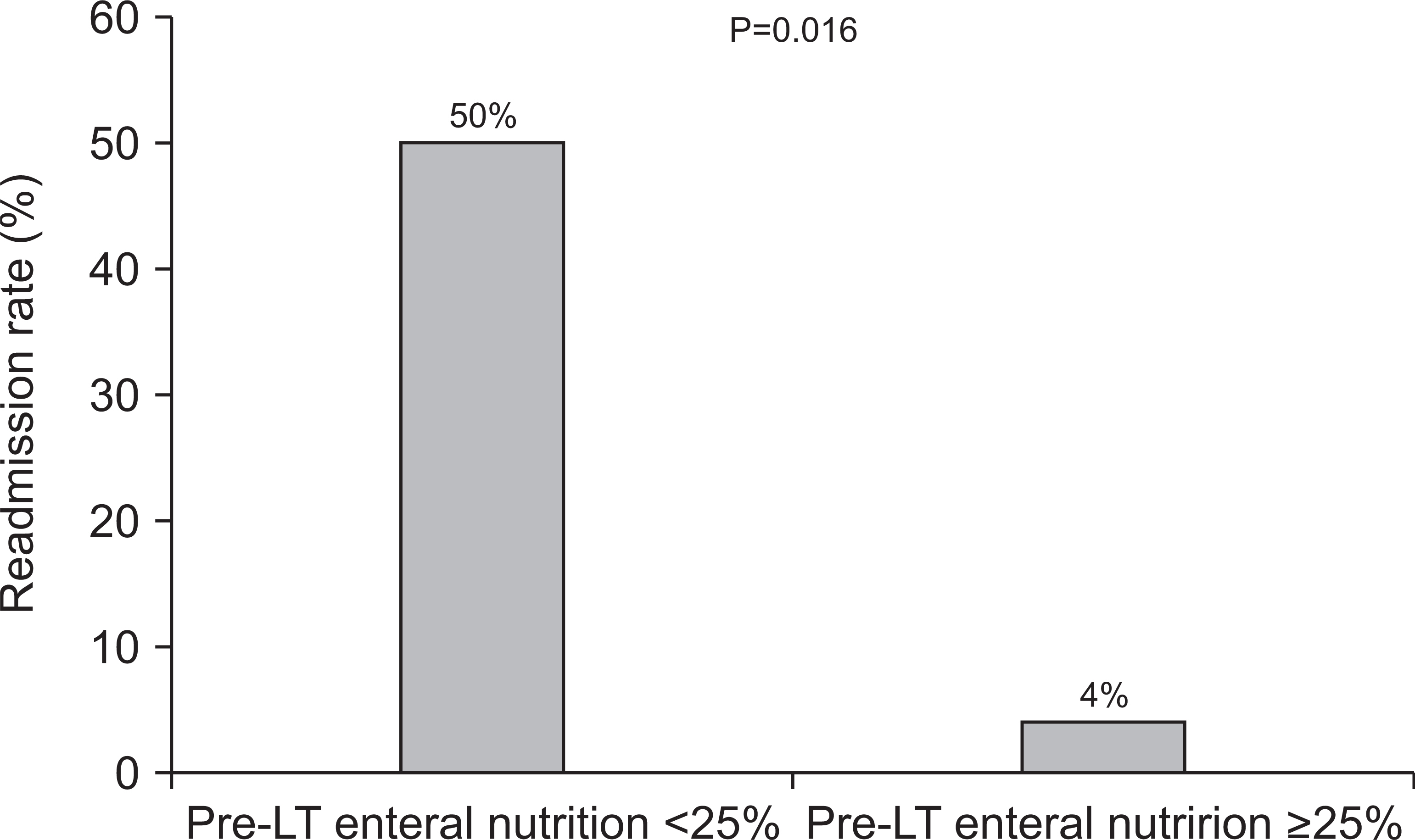Korean J Transplant.
2020 Mar;34(1):38-46. 10.4285/kjt.2020.34.1.38.
Poor preoperative enteral nutrition would be a risk factor for readmission due to infection after liver transplantation
- Affiliations
-
- 1Department of Surgery, Kosin University College of Medicine, Busan, Korea
- 2Nutritional Support Team, Kosin University Gospel Hospital, Busan, Korea
- 3Department of Internal Medicine, Kosin University College of Medicine, Busan, Korea
- 4Department of Neurosurgery, Kosin University College of Medicine, Busan, Korea
- KMID: 2503781
- DOI: http://doi.org/10.4285/kjt.2020.34.1.38
Abstract
- Background
Most patients who undergo liver transplantation (LT) have advanced cirrhosis and poor nutritional status. The aim of this study was to investigate the effect of enteral nutrition (EN) on the clinical outcomes after LT.
Methods
From 2015 to 2019, the medical records of recipient of LT at Kosin University Gospel Hospital were retrospectively reviewed.
Results
Thirty-seven patients underwent LT. Nineteen patients underwent living donor liver transplantation (LDLT) and 18 patients underwent deceased donor liver transplantation (DDLT). One LDLT patient was excluded because transplantation was done within 1 month. Five DDLT patients were excluded either because they died within 1 month (n=4) or received transplantation within 1 month. (n=1). Therefore, 31 patients were analyzed. Psoas-muscle index (P=0.715) and serum albumin (P=0.111) were not statistically different between the LDLT and DDLT groups. Four patients (4/31) were readmitted because of infection. One LDLT patient was diagnosed with genitourinary infection. The three DDLT patients were diagnosed with pulmonary tuberculosis (n=1), diverticulitis (n=1), and sepsis (n=1). Readmission caused by infection was not statistically different between LDLD and DDLT patients (P=0.284). Preoperative EN <25% of the recommended amount (P=0.016) was significantly associated with readmission related to infection. In multivariate analyses, preoperative EN <25% was an independent risk factor for readmission due to infection after LT regardless of psoas-muscle index, baseline Model for End-Stage Liver Disease score, or LT type.
Conclusions
Preoperative poor EN is significantly associated with readmission risk due to infection within 3 months of LT.
Figure
Reference
-
Merli M., Giusto M., Gentili F., Novelli G., Ferretti G., Riggio O, et al. 2010. Nutritional status: its influence on the outcome of patients undergoing liver transplantation. Liver Int. 30:208–14. DOI: 10.1111/j.1478-3231.2009.02135.x. PMID: 19840246.
ArticleStephenson GR., Moretti EW., El-Moalem H., Clavien PA., Tuttle-Newhall JE. 2001. Malnutrition in liver transplant patients: preoperative subjective global assessment is predictive of outcome after liver transplantation. Transplantation. 72:666–70. DOI: 10.1097/00007890-200108270-00018. PMID: 11544428.Kaido T., Mori A., Ogura Y., Ogawa K., Hata K., Yoshizawa A, et al. 2012. Pre- and perioperative factors affecting infection after living donor liver transplantation. Nutrition. 28:1104–8. DOI: 10.1016/j.nut.2012.02.007. PMID: 23044161.
ArticleKaido T., Mori A., Ogura Y., Hata K., Yoshizawa A., Iida T, et al. 2010. Impact of enteral nutrition using a new immuno-modulating diet after liver transplantation. Hepatogastroenterology. 57:1522–5. PMID: 21443114.European Association for the Study of the Liver. 2019. EASL Clinical Practice Guidelines on nutrition in chronic liver disease. J Hepatol. 70:172–93. DOI: 10.1016/j.jhep.2018.06.024. PMID: 30144956. PMCID: PMC6657019.Tandon P., Raman M., Mourtzakis M., Merli M. 2017. A practical approach to nutritional screening and assessment in cirrhosis. Hepatology. 65:1044–57. DOI: 10.1002/hep.29003. PMID: 28027577.
ArticleTandon P., Ney M., Irwin I., Ma MM., Gramlich L., Bain VG, et al. 2012. Severe muscle depletion in patients on the liver transplant wait list: its prevalence and independent prognostic value. Liver Transpl. 18:1209–16. DOI: 10.1002/lt.23495. PMID: 22740290.
ArticleDiMartini A., Cruz RJ Jr Jr., Dew MA., Myaskovsky L., Goodpaster B., Fox K, et al. 2013. Muscle mass predicts outcomes following liver transplantation. Liver Transpl. 19:1172–80. DOI: 10.1002/lt.23724. PMID: 23960026. PMCID: PMC4382961.
ArticleShen W., Punyanitya M., Wang Z., Gallagher D., St-Onge MP., Albu J, et al. 2004. Total body skeletal muscle and adipose tissue volumes: estimation from a single abdominal cross-sectional image. J Appl Physiol (1985). 97:2333–8. DOI: 10.1152/japplphysiol.00744.2004. PMID: 15310748.
ArticleKim JM., Joh JW., Kim HJ., Kim SH., Rha M., Sinn DH, et al. 2015. Early enteral feeding after living donor liver transplantation prevents infectious complications: a prospective pilot study. Medicine (Baltimore). 94:e1771. DOI: 10.1097/MD.0000000000001771. PMID: 26554774. PMCID: PMC4915875.Kamo N., Kaido T., Hamaguchi Y., Uozumi R., Okumura S., Kobayashi A, et al. 2018. Impact of enteral nutrition with an immunomodulating diet enriched with hydrolyzed whey peptide on infection after liver transplantation. World J Surg. 42:3715–25. DOI: 10.1007/s00268-018-4680-0. PMID: 29785692.
ArticleKaido T., Ogawa K., Fujimoto Y., Ogura Y., Hata K., Ito T, et al. 2013. Impact of sarcopenia on survival in patients undergoing living donor liver transplantation. Am J Transplant. 13:1549–56. DOI: 10.1111/ajt.12221. PMID: 23601159.
ArticlePlank LD., McCall JL., Gane EJ., Rafique M., Gillanders LK., McIlroy K, et al. 2005. Pre- and postoperative immunonutrition in patients undergoing liver transplantation: a pilot study of safety and efficacy. Clin Nutr. 24:288–96. DOI: 10.1016/j.clnu.2004.11.007. PMID: 15784491.
ArticleIkegami T., Shirabe K., Yoshiya S., Yoshizumi T., Ninomiya M., Uchiyama H, et al. 2012. Bacterial sepsis after living donor liver transplantation: the impact of early enteral nutrition. J Am Coll Surg. 214:288–95. DOI: 10.1016/j.jamcollsurg.2011.12.001. PMID: 22244203.
ArticleMoore FA., Moore EE. 2009. The evolving rationale for early enteral nutrition based on paradigms of multiple organ failure: a personal journey. Nutr Clin Pract. 24:297–304. DOI: 10.1177/0884533609336604. PMID: 19483059.
ArticleChassaing B., Etienne-Mesmin L., Gewirtz AT. 2014. Microbiota-liver axis in hepatic disease. Hepatology. 59:328–39. DOI: 10.1002/hep.26494. PMID: 23703735. PMCID: PMC4084781.
ArticleGrąt M., Wronka KM., Lewandowski Z., Grąt K., Krasnodębski M., Stypułkowski J, et al. 2017. Effects of continuous use of probiotics before liver transplantation: a randomized, double-blind, placebo-controlled trial. Clin Nutr. 36:1530–9. DOI: 10.1016/j.clnu.2017.04.021. PMID: 28506447.
Article




